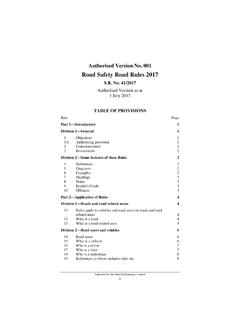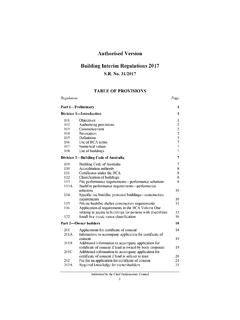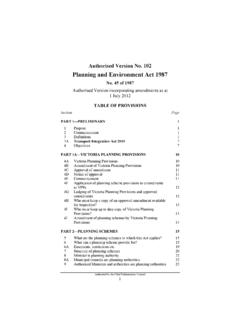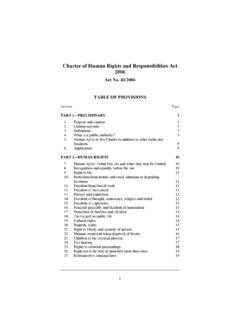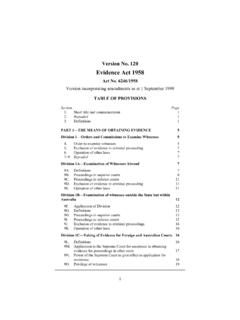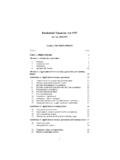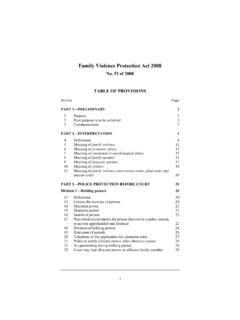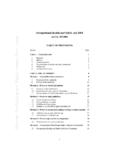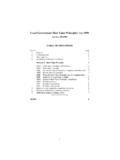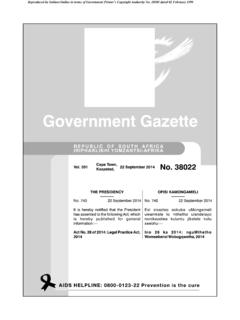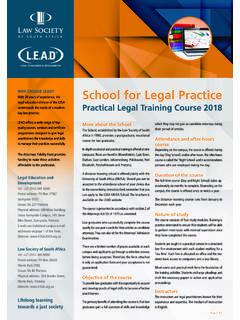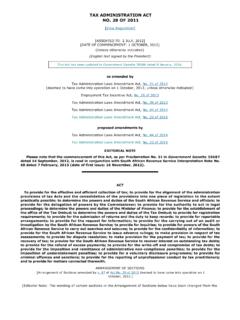Transcription of Mental Health Act 2014 - legislation.vic.gov.au
1 I Mental Health Act 2014 No. 26 of 2014 TABLE OF PROVISIONS Section Page PART 1 PRELIMINARY 1 1 Purposes 1 2 Commencement 2 3 Definitions 3 4 What is Mental illness? 15 5 What are the treatment criteria? 16 6 What is treatment? 17 7 What is medical treatment? 17 8 Provision of advice, notification or information under this Act 18 9 Act binds the Crown 18 PART 2 OBJECTIVES AND Mental Health PRINCIPLES 20 10 Objectives 20 11 The Mental Health principles 21 PART 3 PROTECTION OF RIGHTS 23 Division 1 Statement of rights 23 12 What is a statement of rights? 23 13 Statement of rights must be explained 23 Division 2 Right to communicate 24 14 Definition 24 15 Right to communicate 24 16 Restriction on right to communicate 24 17 Persons to be notified of restriction on inpatient's right to communicate 25 18 Restriction on right to communicate to be monitored regularly 26 Division 3 Advance statements 26 19 What is an advance statement?
2 26 20 Making an advance statement 26 21 Revoking an advance statement 27 22 Advance statement must not be amended 28 Section Page ii Division 4 Nominated persons 28 23 Role of nominated person 28 24 Nomination of nominated person 28 25 Revocation of nomination 29 26 Revocation of nomination by person who made the nomination 30 27 Nominated person may decline to act as nominated person at any time 30 PART 4 COMPULSORY PATIENTS 32 Division 1 Assessment Orders 32 28 What is an Assessment Order? 32 29 Criteria for an Assessment Order 32 30 Making an Assessment Order 33 31 Contents of an Assessment Order 34 32 Information requirements in relation to an Assessment Order 34 33 Person subject to an Inpatient Assessment Order to be taken to a designated Mental Health service 35 34 Duration of an Assessment Order 36 35 Variation of an Assessment Order 37 36 Assessment of person subject to Assessment Order by authorised psychiatrist 39 37 Revocation or expiry of an Assessment Order 39 38 Treatment during an Assessment Order 40 Division 2 Court Assessment Orders 41 39 Examination by authorised psychiatrist 41 40 Notification requirements in relation to Court Assessment Orders 42 41
3 Variation of a Court Assessment Order 43 42 Treatment during Court Assessment Order 44 43 Authorised psychiatrist to provide report to court 45 44 Authorised psychiatrist may make Temporary Treatment Order 46 Division 3 Temporary Treatment Orders 47 45 What is a Temporary Treatment Order? 47 46 Authorised psychiatrist may make Temporary Treatment Order 47 47 Restriction on who can make Temporary Treatment Order 48 48 Community or Inpatient Temporary Treatment Order? 49 49 Contents of a Temporary Treatment Order 50 50 Information and other requirements in relation to Temporary Treatment Orders 50 51 Duration of a Temporary Treatment Order 52 Section Page iii Division 4 Treatment Orders 52 52 What is a Treatment Order?
4 52 53 Tribunal to determine whether to make person subject to Treatment Order 52 54 Authorised psychiatrist may make an application for a Treatment Order 53 55 Making a Treatment Order 54 56 Contents of a Treatment Order 55 57 Duration of a Treatment Order 55 Division 5 Variation of Temporary Treatment Orders and Treatment Orders 56 58 Variation of Temporary Treatment Orders and Treatment Orders 56 59 Requirements in relation to varied Temporary Treatment Orders and Treatment Orders 57 Division 6 Revocation and Expiry of Temporary Treatment Orders and Treatment Orders 59 60 Application to Tribunal to revoke Temporary Treatment Order or Treatment Order 59 61 Revocation of Temporary Treatment Order or Treatment Order if treatment criteria do not apply 59 62 Expiry of Temporary Treatment Order or Treatment Order if certain other Orders made 60 63 Notification requirements for expired or revoked Temporary Treatment Orders and Treatment Orders 60 Division 7 General provisions 61 64 Leave of absence with approval 61 65 Another designated Mental Health service to provide assessment or treatment variation by authorised psychiatrist or as directed by chief psychiatrist 64 66 Application for review of direction to vary Order 67 67 Effect of detention in custody on certain Orders 68 PART 5 TREATMENT 69 Division 1 Capacity and informed consent 69 68 Capacity to give informed
5 Consent under this Act 69 69 Meaning of informed consent 70 70 Presumption that person has capacity to give informed consent 72 71 When a patient does not give consent to treatment 72 Section Page iv Division 2 Treatment 74 72 Patients to be treated for Mental illness 74 73 Circumstances in which patient's preferences in advance statement may be overridden 74 Division 3 Medical treatment 75 74 Giving informed consent to medical treatment 75 75 Who may consent to medical treatment if patient does not have capacity to give informed consent? 75 76 Matters authorised psychiatrist must take into account if consenting to medical treatment of patient 76 77 Urgent medical treatment 78 Division 4 Second psychiatric opinions 79 78 Definition 79 79 Right to a second psychiatric opinion 79 80 Who may give a second psychiatric opinion?
6 79 81 Functions of a psychiatrist giving a second opinion 80 82 Powers of a psychiatrist giving a second psychiatric opinion 80 83 Reasonable assistance must be provided 82 84 Second psychiatric opinion report 82 85 Authorised psychiatrist must assess entitled patient (other than forensic patient) again in specified circumstances 83 86 Authorised psychiatrist must review entitled patient's treatment in specified circumstances 84 87 Application to chief psychiatrist for review of treatment 84 88 Review by chief psychiatrist 85 89 Application for review may be withdrawn 87 Division 5 Electroconvulsive treatment 88 90 Definition of young person 88 91 Meaning of a course of electroconvulsive treatment 88 92 When may electroconvulsive treatment be performed?
7 89 93 Application to Tribunal to perform electroconvulsive treatment on a patient who is not a young person 90 94 Application to perform electroconvulsive treatment on a young person 91 95 Listing of electroconvulsive treatment applications by Tribunal 93 96 Powers of Tribunal in respect of electroconvulsive treatment application 94 97 Order approving electroconvulsive treatment 96 98 Electroconvulsive treatment must not be performed in certain circumstances 96 99 Use of electroconvulsive treatment to be reported to chief psychiatrist 97 Section Page v Division 6 Neurosurgery for Mental illness 98 100 Psychiatrist may apply to Tribunal for approval to perform neurosurgery for Mental illness 98 101 Listing of application to perform neurosurgery for Mental illness 98 102 Powers of Tribunal in respect of application for neurosurgery for Mental illness 98 103 Notice of decision 99 104 Report to chief psychiatrist 100 PART 6 RESTRICTIVE INTERVENTIONS 101 Division 1 General 101 105 When may a restrictive intervention be used?
8 101 106 Facilities and supplies to be provided to person 101 107 Notification of use of restrictive intervention 101 108 Use of restrictive intervention to be reported to chief psychiatrist 102 109 Release from restrictive intervention 102 Division 2 Seclusion 102 110 When may seclusion be used? 102 111 Use of seclusion to be authorised 103 112 Monitoring of person in seclusion 104 Division 3 Bodily restraint 104 113 When may a bodily restraint be used? 104 114 Use of bodily restraint to be authorised 105 115 Urgent use of bodily restraint without authorisation 106 116 Monitoring of person on whom a bodily restraint is used 106 PART 7 ADMINISTRATION 108 Division 1 The Secretary 108 117 Role of Secretary 108 118 Functions of the Secretary 108 Division 2 The chief psychiatrist 109 119 The chief psychiatrist 109 120 The role of the chief psychiatrist 110 121 Functions of the chief psychiatrist 110 122 Investigations by chief psychiatrist 112 123 Powers of entry 113 124 Power to give written direction to persons to produce documents or answer questions 114 Section Page vi 125 Member of staff of Mental Health service provider to give
9 Any reasonable assistance 115 126 Report and recommendations following investigation by chief psychiatrist 115 127 Report and response to be given to the Secretary 116 128 Publication and response 116 129 Chief psychiatrist may give written directions to Mental Health service providers 117 130 Chief psychiatrist may conduct clinical reviews 118 131 Chief psychiatrist to give notice of intention to conduct clinical review 118 132 Clinical review reports and recommendations 119 133 Standards, guidelines or practice directions to address systemic issues identified in clinical review 120 134 Chief psychiatrist may conduct clinical practice audit 120 135 Chief psychiatrist must make record 120 136 Reports 120 137 Reports to be given to the Secretary 121 138 Publication of report 121 139 Standards.
10 Guidelines or practice directions to address systemic issues identified in clinical practice audit 121 140 Confidentiality obligations applying in respect of information from clinical practice audit or clinical review 121 141 Confidentiality of documents 123 142 Provision of staff 124 143 Contractors 124 144 Power of chief psychiatrist to delegate 124 145 Reports submitted by the chief psychiatrist 125 Division 3 Authorised officers 126 146 Chief psychiatrist may appoint authorised officers 126 147 Identity cards 127 148 Production of identity card 127 Division 4 Designated Mental Health services 128 149 Emergency declaration of designated Mental Health services 128 150 Appointment of authorised psychiatrist 128 151 Authorised psychiatrist may delegate powers and functions 129 PART 8 Mental Health TRIBUNAL 131 Division 1 Establishment of the Mental Health Tribunal 131 152 Establishment of the Mental Health Tribunal 131 153 Functions of the Tribunal 131 154 General powers of the Tribunal 132 155 Protection of members.
